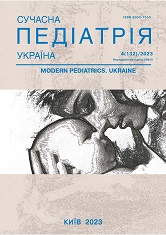Assessment of immunological indicators in children with behavioral disorders due to perinatal cerebrovascular lesions
DOI:
https://doi.org/10.15574/SP.2023.132.67Keywords:
children, immunological indicators, regulatory peptides, perinatal cerebrovascular lesions, mental disorders, behavioral disordersAbstract
Purpose - a comprehensive study of the immune system of patients with deviant behavior due to perinatal pathology.
Materials and methods. The sample consisted of 43 boys aged 7 to 15 years with a history of perinatal hemorrhagic and hypoxic-ischemic cerebrovascular injuries, which later provoked various forms of non-psychotic deviant behavior. To check the results, a control group consisting of 43 mentally and physically healthy children and adolescents was selected. The main group, which showed persistent deviant behavior, was prescribed a drug whose active substance is dalargin, a peptide compound whose structure includes 6 amino acid residues.
Clinical-amnestic, clinical-psychopathological, neurosonography was used to diagnose perinatal cerebrovascular injuries in newborns (in history) with subsequent use of computed tomography (CT) and magnetic resonance imaging (MRI) methods, statistical data processing was carried out using «SPSS 16.0» and «Excel» programs from the «Microsoft Office 2003» package.
Results. The study of T- and so-called T-active lymphocytes of the peripheral blood showed that before treatment, a significant decrease in the content of these cells was observed in children (to 4.26±0.80% and 22.42±0.69% against 65.81±1.66% 44.42±1.25% in the control group, p>0.05). Proliferative activity changes significantly in response to T- and B-mitogens. Proliferative activity recovered completely (25.56±3.26% and 59.72±2.19% vs. 57.23±1.51% in the control group).
Conclusions. Children and adolescents with pronounced deviant behavior of residual organic genesis, resistant to traditional therapy, are characterized by significant changes in the immune status caused by dysimmunoglobulinemia, imbalance of the lymphocyte subpopulation, suppression of the functional activity of these populations on mitogens, which indicates secondary immunodeficiency. The therapeutic effectiveness of the dalargin-peptide compound is determined by its function as an immunocorrector in treatment-resistant behavioral disorders.
The research was carried out in accordance with the principles of the Helsinki Declaration. The study protocol was approved by the Local Ethics Committee of participating institution. The informed consent of the patient was obtained for conducting the studies.
No conflict of interests was declared by the authors.
References
Boltivets S, Gonchar T, Cheliadyn Y, Bashynskyi O, Uralova L. (2021, Sep). Age Dynamics of Deviant Behavior and Mental Pathology Among Patients with Residual-Organic Neurosis-Like Disorders. Bahrain Medical Bulletin. 43: 3. URL: https://www.bahrainmedicalbulletin.com/SEPT_2021/BMB-21-88.pdf.
Bowen KE, Gatzke-Kopp LM. (2013). Brain injury as a risk factor for psychopathology. Child and Adolescent Psychopathology. Eds. T.P. Beauchaine, S.P. Hinshaw. Hoboken, New Jersey: John Wiley & Sons: 317-340.
Gładysz D, Krzywdzińska A, Hozyasz KK. (2018). Immune Abnormalities in Autism Spectrum Disorder - Could They Hold Promise for Causative Treatment? Mol Neurobiol. 55: 6387-6435. https://doi.org/10.1007/s12035-017-0822-x; PMid:29307081 PMCid:PMC6061181
Herz J, Bendix I, Felderhoff-Müser U. (2022). Peripheral immune cells and perinatal brain injury: a double-edged sword? Pediatr Res. 91: 392-403. https://doi.org/10.1038/s41390-021-01818-7; PMid:34750522 PMCid:PMC8816729
Kentner AC, Bilbo SD, Brown AS et al. (2019). Maternal immune activation: reporting guidelines to improve the rigor, reproducibility, and transparency of the model. Neuropsychopharmacol. 44: 245-258. https://doi.org/10.1038/s41386-018-0185-7; PMid:30188509 PMCid:PMC6300528
Leavy A, Jimenez Mateos EM. (2020). Perinatal Brain Injury and Inflammation: Lessons from Experimental Murine Models. Cells. 9 (12): 2640. Published 2020 Dec 8. https://doi.org/10.3390/cells9122640; PMid:33302543 PMCid:PMC7764185
Räikkönen K, Gissler M, Kajantie E. (2020). Associations Between Maternal Antenatal Corticosteroid Treatment and Mental and Behavioral Disorders in Children. JAMA. 323 (19): 1924-1933. https://doi.org/10.1001/jama.2020.3937; PMid:32427304 PMCid:PMC7237984
Sharova O, Smiyan O, Boren T. (2021, Dec). Immunological effects of cerebral palsy and rehabilitation exercises in children. Brain, Behavior, & Immunity - Health. 18: 100365. https://doi.org/10.1016/j.bbih.2021.100365; PMid:34704080 PMCid:PMC8522480
Spann MN, Monk C, Scheinost D, Peterson BS. (2018, Mar 14). Maternal Immune Activation During the Third Trimester Is Associated with Neonatal Functional Connectivity of the Salience Network and Fetal to Toddler Behavior. Journal of Neuroscience. 38 (11): 2877-2886. https://doi.org/10.1523/JNEUROSCI.2272-17.2018; PMid:29487127 PMCid:PMC5852665
Downloads
Published
Issue
Section
License
Copyright (c) 2023 Modern pediatrics. Ukraine

This work is licensed under a Creative Commons Attribution-NonCommercial 4.0 International License.
The policy of the Journal “MODERN PEDIATRICS. UKRAINE” is compatible with the vast majority of funders' of open access and self-archiving policies. The journal provides immediate open access route being convinced that everyone – not only scientists - can benefit from research results, and publishes articles exclusively under open access distribution, with a Creative Commons Attribution-Noncommercial 4.0 international license (СС BY-NC).
Authors transfer the copyright to the Journal “MODERN PEDIATRICS. UKRAINE” when the manuscript is accepted for publication. Authors declare that this manuscript has not been published nor is under simultaneous consideration for publication elsewhere. After publication, the articles become freely available on-line to the public.
Readers have the right to use, distribute, and reproduce articles in any medium, provided the articles and the journal are properly cited.
The use of published materials for commercial purposes is strongly prohibited.

